Starting any business is inextricably linked with risk. It's natural to question how successful your product will be. But what if we said there is a quick and effective way to test the viability of your business idea, even with limited investment? Yes, it is an MVP! In this article, we will show you how to build a minimum viable product, launch it, and evaluate its effectiveness.
Definition of an MVP
Minimum Viable Product (MVP) is a quick way to test a business idea and see if it's worth investing in its development. Such giants as Airbnb, Uber, Instagram, Linkedin, etc., started with the creation of an MVP. They built simple products that showed how much the target audience is interested in such applications.
The minimum viable product has a limited set of features. This is not a raw version but a complete product with simple functionality. An MVP gives an idea of the potential of a business idea and allows you to find real ways for further development. - Andrey Onopriyenko, CTO at KeyUA
The primary purpose of an MVP is to check the actual demand for your business idea. That’s why it’s worth taking a little time to make a minimum viable product. It is also a good option for companies with a limited budget. After launching an MVP on the market, you get genuine customer reviews that you can use to understand if you are moving in the right direction. And if not, you will be able to relatively quickly figure out what changes are worth taking to make your product a winning one.
Read what Minimum Viable Product means to know more about its benefits and principles.
When You Should Not Build a Minimum Viable Product
For most startups, applying the best practices for making a successful MVP is an excellent chance for growth. However, creating a minimum viable product is not always advisable. You do not need an MVP if:
- You have no monetary limits. If the budget is not an issue for you, you can immediately start building a multifunctional product.
- You are entirely confident that your idea will win the world. But for this, you should conduct a thorough and in-depth analysis of the market, including the characteristics of your competitors.
10 Stages of a Minimum Viable Product Development
MVP gained its popularity due to the Lean Startup methodology. It is an approach that quickly implements business hypotheses and launches them to market. The methodology works on the Build-Measure-Learn principle.
This allows you to bring the product to the market with a relatively small investment and, based on the target audience’s experience, make changes for the development of the business. Now let’s look at the main steps to build an MVP.
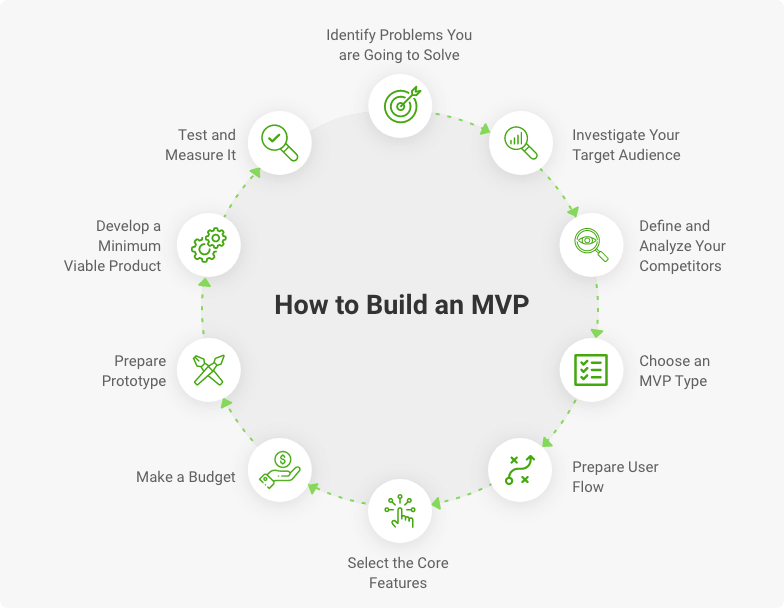
10 Essential steps to build a successful minimum viable product
#1 Identify Problems You are Going to Solve
Developing a successful MVP is built on a winning business idea. At the first stage, you have to determine the main problems that your product will solve. Put yourself in the shoes of your potential user and answer the following questions. Why do they need your product? How can it solve their problems? Why will potential customers use your product?
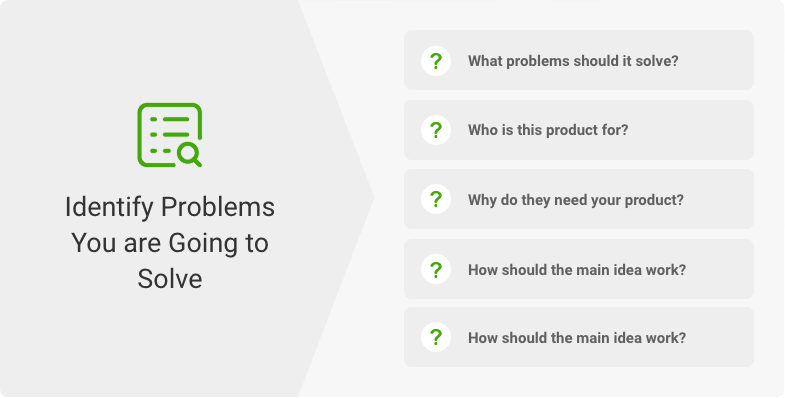
In this case, the MVP should focus on solving the main problem of users. This is a bad idea if you want to address multiple target audience pain points. In this case, you run the risk of creating multifunctional software, which does not solve a single issue of a potential user.
When I got the idea of creating an MVP, I saw the main problem of most job seekers. My experience in selecting and hiring managers and IT professionals has shown that companies spend a lot of time searching for qualified personnel, while decent candidates cannot get a job quickly - and all this is due to incompetent paperwork. - Yana Trihub, Sales Director at KeyUA & Founder of GetCoverLetter
This is how our team came up with the basic concept of GetCoverLetter - an app for creating eye-catching cover letters. Why Cover Letters? Because resumes are faceless. It reflects the qualifications of the candidate, but an effective employee is more than just a qualification. A cover letter is what grabs the recruiter's attention and motivates them to meet the candidate in person.
#2 Investigate Your Target Audience
The next step is to study your target audience in more detail. You should know absolutely everything about them, especially their main pain points. You will not be able to attract absolutely all users to your product. A ton of low-quality leads will waste your marketing budget, while a small but well-crafted target audience can really make a fortune.
At KeyUA, while developing the concept of the GetCoverLetter, we created a buyer personas. This is a portrait of the ideal user that can include gender, age, location, profession, and even the annual income of your target audience.
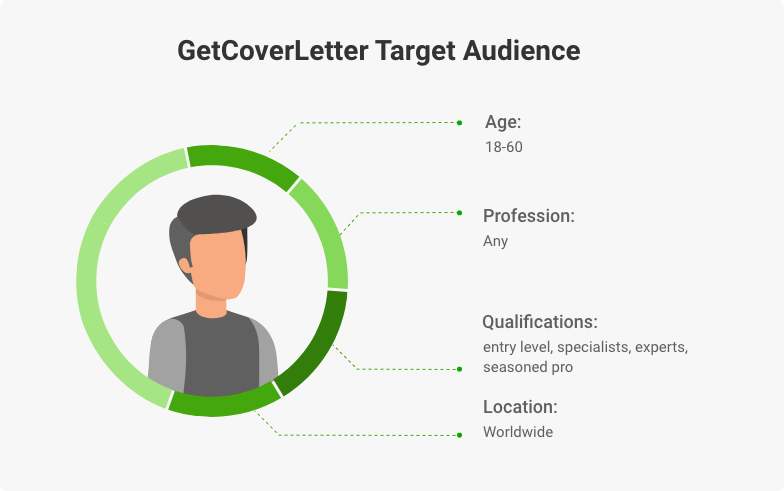
In doing so, the target audience can even be divided into groups. The more detailed you know your customer, the more effective product you can build and spend less on marketing.
Here are the main aspects for creating the buyer personas:
- Identify the pain points of your customers. What prevents them from reaching their goal? What obstacles do they meet on their way to solving the problem?
- Define the main goals and aspirations of your target audience. What motivates your customers? What exactly do they want?
- Analyze and determine how you can help your customers solve problems with their pain points. Which product will meet their demand?
- Determine the driving force behind your target audience. What factors make my potential user buy a product? What is more important to them: design or functionality? What are their main criteria for assessing the quality of a product? How important is the pricing policy for them?
- Bring together the analysis of all of the above points to get your buyer personas.
#3 Define and Analyze Your Competitors
It's okay if the brilliant idea of creating an MVP doesn’t just come to you. There is a chance that a similar product already exists on the market. But this is not a reason to give up. On the contrary, this is a great opportunity to study competitors and use their weaknesses to your advantage.
Competitor analysis is extremely important, even if you think you have a unique idea. Check at least 3 products similar to what you are going to implement. Analyze their development history as well as the unique values they provide. Pay attention to their sales volumes and try to determine profitability. This will help you understand their success and identify strategies in which you can succeed.
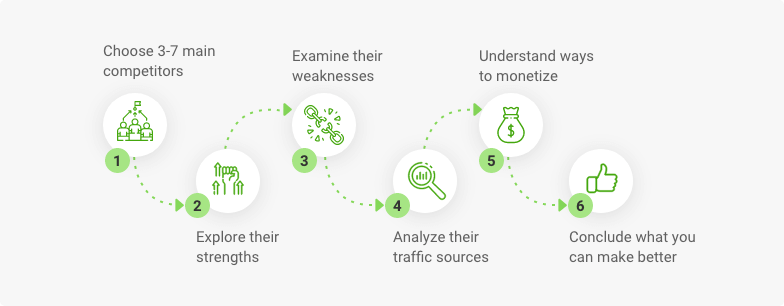
It is also good to research competitors' websites or apps for monthly traffic, design, and usability and carefully study their functionality. Pay attention to reviews on independent resources. This will allow you to understand your competitors' flaws and eliminate them from your product.
When building GetCoverLetter, we started competitors' analysis with Ahrefs. It allowed us to understand the volumes and sources of their traffic. Next, we investigated the main functions in more detail to understand what value we can provide to the target audience.
#4 Choose an MVP Type
Before proceeding with MVP development for a startup, you need to decide on its type. This is a crucial step as it will further influence the budget, implementation process, and promotion methods. There are 7 main types:
- The Fake Door
- Landing Page MVP
- Email Campaign MVP
- Marketing Campaign MVP
- Single-Feature MVP
- Pre-order MVP
- Concierge MVP
- Wizard of Oz MVP
- Piecemeal MVP
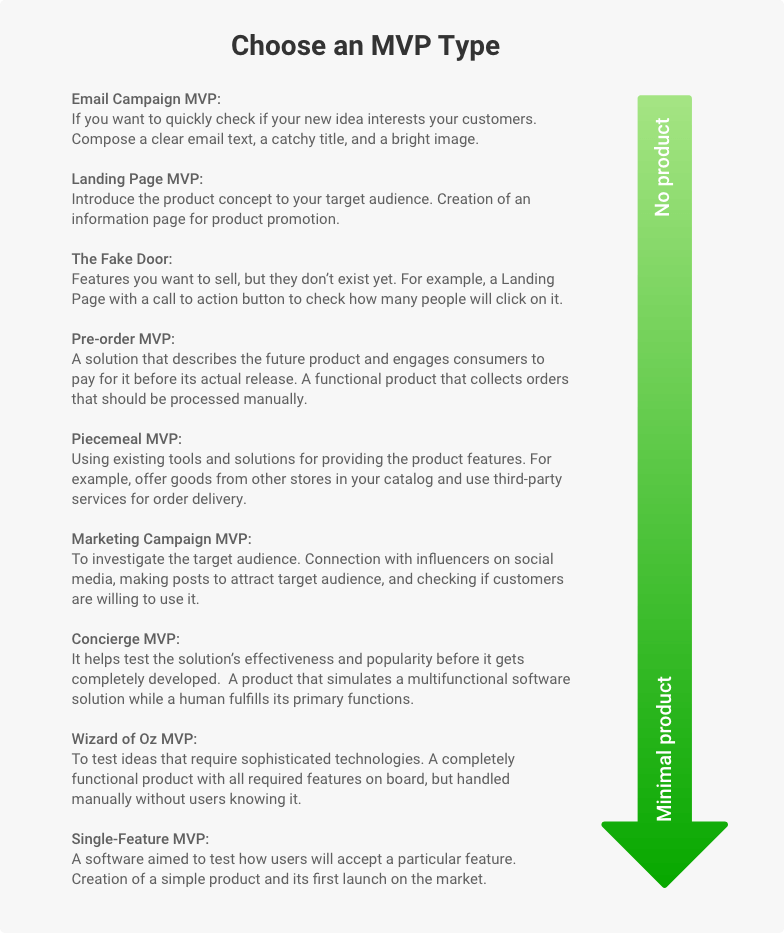
The choice of the type of MVP will determine its future fate. Read more about the Types of MVP to decide which one suits you best.
#5 Prepare User Flow
Visualizing the user flow will help you better understand how the application should work. At this stage, you have to analyze the customer experience when interacting with your product. At the same time, don’t just focus on specific functions but also on user steps and ways to simplify the process.
In order to create a user flow, you have to answer a number of questions:
- Who is your target audience?
- What results do your users want?
- What actions will they take to achieve this?
Let's analyze the user flow on the example of GetCoverLetter.
The target audience is job seekers. They want a quality cover letter with minimal effort. The actions that they will perform - register in the system, provide information about themselves and the desired profession - receive a ready-made cover letter.
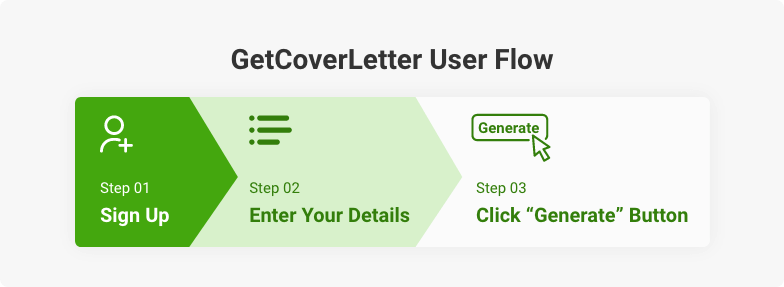
The main goal of creating a customer flow is to determine the value of your product and ways to increase it.
#6 Select the Core Features
The essence of an MVP is to provide users with software with a minimum set of functions that can solve their problems. Therefore, it is essential to determine what will be included in the initial version at this stage of minimum viable product development. Any additional features can be added later after the product test.
GetCoverLetter is a builder that allows users to create custom and eye-catching cover letters and resumes automatically. The web resource also offers a wealth of useful information to help candidates prepare effectively for an interview or succeed in their job searches.
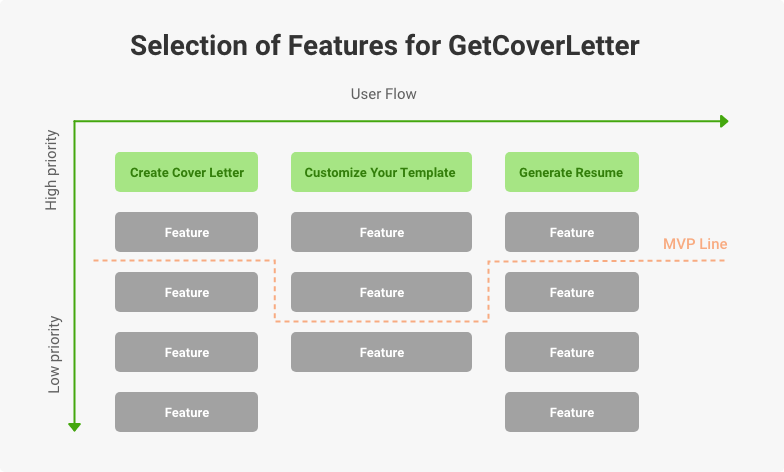
But when building an MVP, we focus on the main functionality, namely the editor, which automatically created and allowed users to customize the cover letters only. All subsequent functionality was added later after the main idea received a positive response from the target audience.
An MVP must be scalable. In the process of listing the functions of the product, it is worth considering how they will develop in the future. At this stage, it is also essential to consider how you will monetize your product.
Make a list of all the functionality you want to implement in your product. After that, prioritize them. MVP development implies the implementation of only that functionality, without which the product cannot exist. All subsequent features can be realized after evaluating the market response to a business idea.
To prioritize features, ask yourself, "what is the most important action I want my users to take?" The answer will be exactly the basis on which you need to build the system. After that, write down more functions that you would like to see in your product and describe why they are needed.
Once you have completed the list, it's worth dividing it into 3 main categories: "must", "useful", "maybe". The first category is exactly those functions that must be implemented in an MVP. The second one contains functionality that can be added after the minimum viable product has shown its effectiveness. And the last list is the features that can be realized after the product takes its niche.
To create a minimum viable product that will succeed, it is crucial to understand that the initial version may be primitive (but not crude). Thus, by focusing only on the basic features, you significantly save the budget for testing your business idea.
#7 Make a Budget
Premature budget consumption is one of the most frequent reasons for the failure of startups. Therefore, we recommend planning it in advance. You already have the necessary set of features and the type of MVP, which means we can approximately evaluate the cost of development. Also, this amount is worth adding the cost of launching and promoting the product.
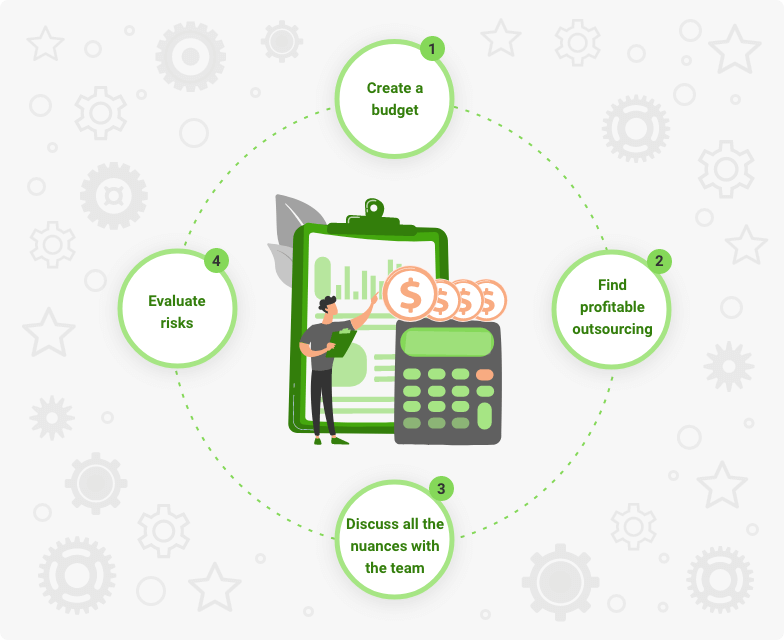
It is normal if you have some budget constraints. Many successful companies (for example, Airbnb) began in the same conditions. So it is crucial to plan the budget in advance. If you do not have enough funds to implement the full functionality, you can find an alternative or simplify functions.
In any case, before starting MVP product development, it is worth discussing all the nuances with the team in detail, including the cost of implementing each functionality. Also, the outsourcing model of the partnership allows you to significantly save the budget. The cost of developing software by specialists from Eastern Europe is lower than in the United States, although the code quality will not be lower.
#8 Prepare Prototype
Although this is not a mandatory step, it is highly recommended, especially if the budget allows it. As we said, the MVP is not a raw product. It is a fully working version that should have convenient functionality and a beautiful design. Prototyping allows you to choose the most attractive option for users.
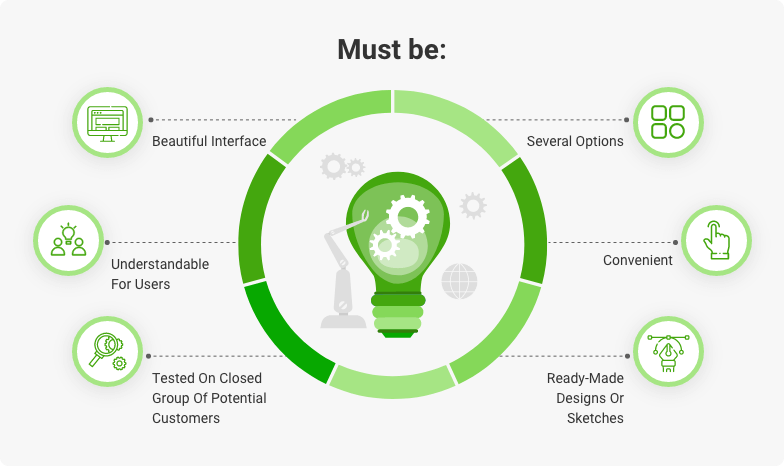
The prototype involves creating several variants of the product’s visual design without creating a functionality. It can be ready-made designs or sketches. Next, they are tested on a closed group of potential customers to determine which option is the most convenient, understandable, and attractive.
If the prototyping does not fit your budget, take care of at least the creation of UI. This is the design of your future product. Use user flow for its development. It must be comfortable and intuitive. Avoid overloading various elements.
#9 Develop a Minimum Viable Product
This is the most time-consuming step. Software developers create the architecture and program the product’s source code based on a list of priority features.
Before starting the development phase, you should choose a reliable contractor. The development team significantly affects the cost of creating a product. There are 4 main types of cooperation:
- In-House. You form a development team yourself in your office.
- Outsourcing. You are hiring a company that already has an experienced development team.
- Outstaffing. You hire individual specialists from a software development company who may even relocate to your office.
- Freelance. You select and hire independent software developers.
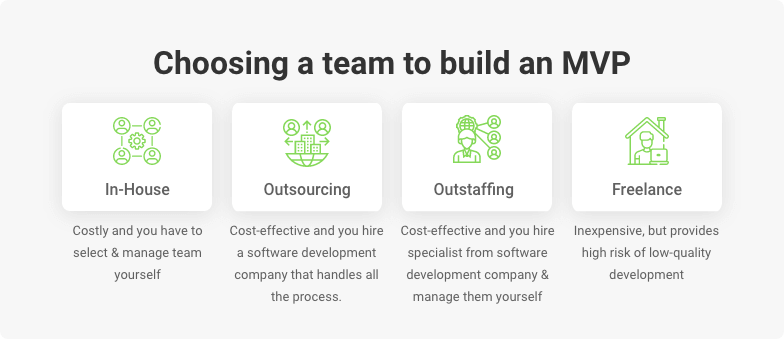
Consider the various types of interaction with the development team and their advantages and disadvantages by reading about In-House vs Outsourcing Software Development.
Before you start building an MVP for a startup, you need to discuss all the details with the team. Ask them in advance for an estimate of the project. Creating a minimum viable product involves rapid development. Therefore, the construction of the web or mobile app should not exceed 3-4 months.
Want to get a more detailed estimate? Find out how long it takes to build a minimum viable product.
At this stage, the back-end and front-end of the project are created, and special attention is paid to architecture. It must be scalable so that new functionality can be easily integrated into the product in the future. Once the source code is ready, the QA team will test the functionality to make sure it works as expected.
We fully implemented the GetCoverLetter MVP in 4 months, although the total duration of the work was more than 1400 hours. It became possible thanks to Scrum (a type of an Agile methodology of project management) and the work of several developers in parallel.
#10 Test and Measure It
When the product is ready, it goes out into the real world for users to test it and give their feedback. Depending on the type of minimum viable product, such testing can take from a couple of weeks to several months. It must be enough to gauge the market response.
Your target audience is precisely the opinion that you need to be guided by when assessing the success of your MVP. Take their feedback seriously; you can get important and valuable information about what can be improved in your product.
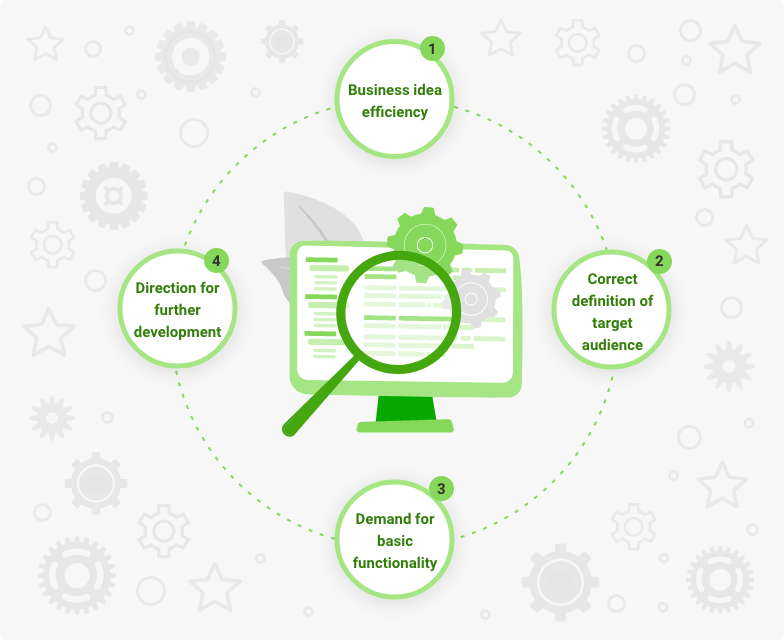
MVP testing and evaluation should show the following aspects:
- whether you defined your target audience correctly;
- The efficiency of your business idea;
- further direction for MVP product development;
Many startups are wary of getting negative reviews after they launch an MVP. In fact, there is nothing to be afraid of. This is valuable information that will help you make the right decision for business development. A bad review is better than no review.
What is the Cost to Build a Minimum Viable Product?
Building an MVP for startups is attractive with minimal time-to-market. And the cost of development can be quite reasonable, although there is no general estimation.
The budget for minimum viable product building depends on the following factors:
- application functionality;
- type of MVP;
- the size of the development team and their location;
- tools and technologies to be applied;
You can get a more detailed estimate by reading the article about MVP Development Cost.
How to Measure MVP Success?
After launching the product on the market, an equally interesting phase begins, namely the assessment of the effectiveness of your product. There are various approaches to measure this. Let's take a look at the criteria that highlight a successful MVP.
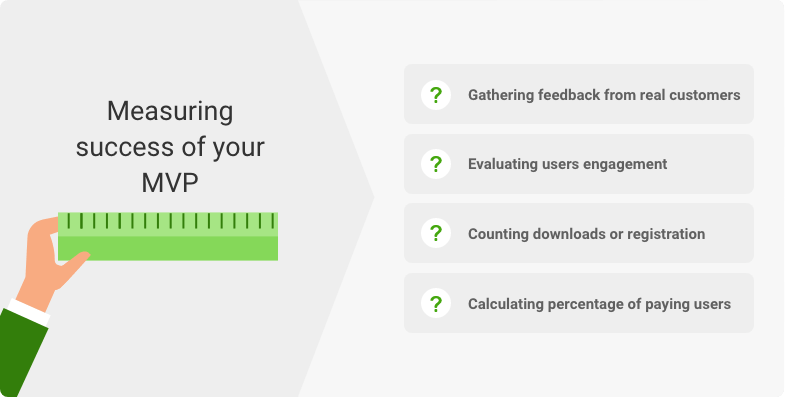
Real feedbacks
After launching an MVP, your support service should work non-stop. They are the ones who receive emails or calls from users regarding the problems they encountered while interacting with your product. Ask your customers to fill out a feedback form to tell you what they liked and disliked while using your application. It will allow you to visually assess how successful your product is.
Engagement, active users
Use tools to collect analytics that show how much time your customers spend interacting with the product. What activity do they show, what pages do they open most often? This will allow you to understand what you can implement to increase user engagement.
Downloads or registration
If you have launched a mobile application, the number of downloads is a good indicator of the demand for your MVP. If your product is a website, track user traffic with SEO analytics tools.
Percentage of paying users
Check out how your monetization strategy works. How many users have bought your services? Analyze if there is an increase in their number (and how much) within a few months.
Final Thoughts
When it comes to starting a business, an MVP is the first thing to do. It is convenient because it requires relatively little investment to assess the relevance of your idea and helps to find a direction for growth.
When building up a minimum viable product, partnering with seasoned professionals is always a good idea. For over 13 years, we have been building and launching successful web and mobile applications to the market. KeyUA experts are happy to assess your requirements, offer powerful recommendations and assist at any stage of building a first-class MVP.
Launch your brilliant idea with KeyUA in a couple of months.
Contact Us








 Unit 1505 124 City Road, London, United Kingdom, EC1V 2NX
Unit 1505 124 City Road, London, United Kingdom, EC1V 2NX

Comments
Leave a comment